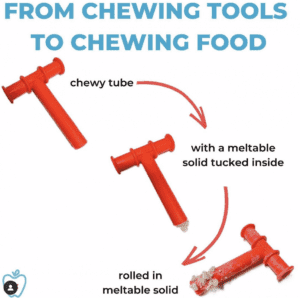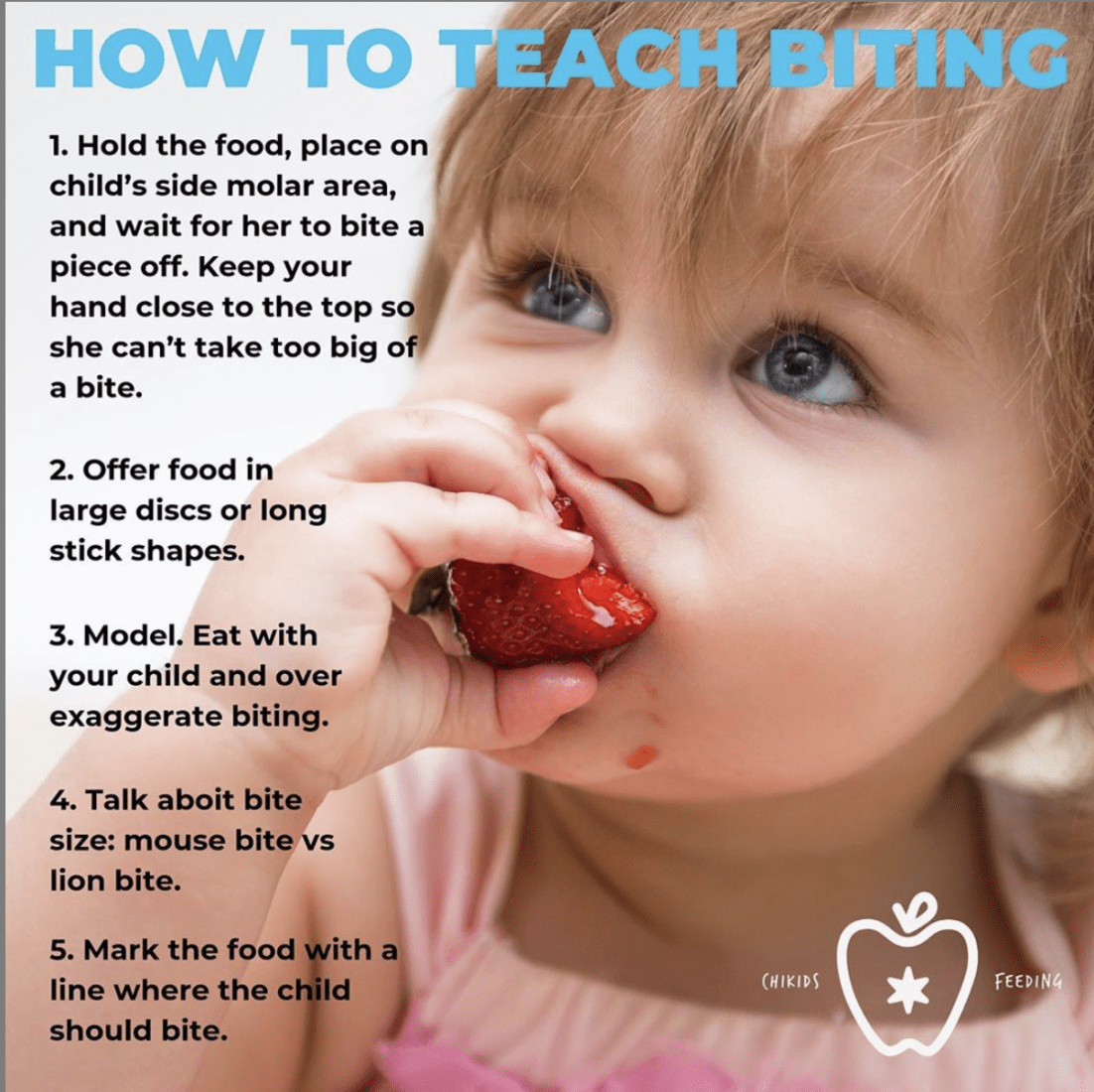
Today we’re covering one of those “what do I do when…” questions that come up for so many babies and toddlers who are learning to eat solids.
For example…
When babies or toddlers aren’t proficient in chewing certain textures yet…and they can pocket food in their mouths. What do you do??
When they’re unsure of what to do when you start solids, or need help exercising their mouth muscles…they may hesitate to chew food and just spit it out. Again..what do you do??
When they’re still learning how to take appropriate sized bites and/or get SO excited about the food they’re eating…they can take giant bites that have our mama hearts pounding so fast we might just die! Again…what do we do??
But fear not… in today’s post I’ve invited my friend and Speech Language Pathologist, Catherine Callahan MS, CCC-SLP, CLC from Chikids Feeding, to give us her tips and tricks to help troubleshoot all these feeding issues. Below are the most common issues and questions that come up from mealtimes with babies and toddlers, and she’s given amazing and detailed answers to help you out.
Let’s dive right in with her answers!
How can I help teach my baby to chew?
Babies begin with a simple up and down motion of their jaw that begins to come under their control between 5 and 9 months. They then advance to a diagonal jaw movement starting around 7-9 months, and later to a circular movement, which is fully developed by about 24 months. Watch for your baby to increase the number of chews and varied size and rhythm, and to advance from up and down to eventually a circular movement by the time they’re 2.
Control and advancement of chewing starts with mouthing. If your baby doesn’t put teething toys or tools in their mouth yet, or your toddler never did that, start there.

Give your child a variety of stick shaped teething toys to chew on daily. If they won’t put it into their mouth on their own, help them. Our goal is to place these tools between the gums or molars on the sides of their mouth.
If your baby won’t chew on a teething toy or tool
Bring it to your baby’s mouth and wait for them to open and accept it. This should be enjoyable and not forced. Try singing, playing games, and moving up from holding it near their hands, arms, and shoulders, to their mouth. Once they’ll allow it in their mouth, place it on their gums in the molar area. Hold it between their gums and wait for them to bite down. If they won’t bite, then give a little gentle downward pressure to their lower gums, and upward pressure to their upper gums. Use slow and steady pressure.
If your baby is chewing on teething toys and tools, but won’t chew food
Try dipping stick shaped teething tools in puree, roll tools in soft foods (like avocado or banana), or roll in crumbs of a meltable solid (only with this texture after they’re crawling), and help your child place this on their molar area for chewing. As described above, hold the tool between their gums and wait for them to bite down. If they won’t bite down, apply a little gentle downward and upward pressure to their gums.

Offer stick shaped foods that are soft (starting after they’re sitting up) and meltable (after they start crawling). When you offer these foods, guide them to put them between their molars. By placing it between the molar area, baby will naturally learn to bite and chew with their teeth vs. smashing with their tongue.
Once baby is crawling (around 8-9 months), place small pieces of soft solid foods (a small cube of soft fruit or vegetable about the size of your pinky fingernail that you can easily squish between your fingers) or a meltable solid (a small piece of a dissolvable puff) between their gums on the sides. When you place a piece of food to the side, baby will bite down, and will shift their tongue to the side you place the food. When they shift their tongue, their jaw will also shift, advancing their chewing skills. Alternate sides to teach the back and forth motion of the tongue and jaw.
MLE feeding tip: Model chewing during meals in an exaggerated way and get silly with it! I say “Chew, Chew, Chew!” and then imitate big up and down chewing motions to the baby, maybe smacking my lips to get their attention and look at my mouth. Try it!
Teaching babies how to bite
Most babies are typically able to take a controlled bite from soft solid foods between 7 and 12 months of age. Teaching a baby to take bites and to chew, also starts with mouthing. If your baby hasn’t done that or if they skipped that step, start there. Once baby is regularly mouthing and chewing on tools, help her to learn this skill by offering stick shaped foods. If they need help, guide these over to their molar area to take bites.

If your child is chewing tools regularly, but is still not biting pieces off, or is taking overly large bites:
For a baby or younger child, offer a stick shaped food and hold it for your child very close on the top, so they’re only able to bite off beyond your fingers which prevents them from getting too much food.
For an older child, make a line on the food so your child can see where to bite. You can use a toothpick to draw a line, or a fork to make a dotted line. I like to tell kids these are the teeth marks, and ask them to bite on the teeth marks.
Teach your child about bite sized pieces. You can show a picture of a mouse and tell them that a mouse “takes small bites” and a picture of a lion, who “takes very big bites.” Talk to your child about the best bite size for their mouth, and then rehearse by having kids identify mouse vs. lion bites on themselves and you.
How do I prevent mouth stuffing?
First, work on improving your child’s oral awareness (the ability to understand and feel food in her mouth, and the borders of the inside of her mouth). Babies learn this through mouthing, typically by 5-9 months of age.
IMPROVE BABY’S ORAL AWARENESS
Brushing inside baby’s mouth (on the top and sides of her tongue, inside her cheeks, and along her gums) with a finger brush or child-sized toothbrush. Do this with tooth brushing and/or just prior to meal times to “wake up” their mouth and get them ready to eat.
While you’re preparing a meal, to help baby practice give them a stick shaped teething tool to bite on. Make this part of your mealtime routine.
TAKING SMALL BITES
While your child is working on improving their oral awareness and sensation in the mouth, help them to learn small bites by only offering 1-2 bites on their tray at a time. It sounds simple, but most of the time, we just need to break the habit and allow baby to practice one bite at a time. Keep their plate of food over to the side, and add new bites to the tray as they eat.
For older children, talk about small bites one at a time, and use pictures (like the lion and mouse described above) to help them understand the difference.
For any age child, offer foods with stronger flavours to boost the sensation or feeling in the mouth. When a child can feel the food, they’ll be less likely to overstuff.
Head over to this blog post to learn more about my Brush-Bite-Boost method (BBB) to help with overstuffing food.
MLE Feeding Tip: If your baby is eating at such a quick pace that they’re gagging and it scares you, try slowing them down further by offering them a child safe food pick or a utensil to pick their food up with. It may just be that eating with their hands is too easy, so having a bit more of a challenge with food picks may do the trick as it takes more concentration!
HOW DO I STOP BABY FROM FREQUENTLY POCKETING FOOD?

“What if my baby holds food in their mouth and won’t swallow?”
With pocketing food, I’d recommend the same strategies as described above with mouth stuffing. Start with mouthing, brushing, and chewing practice. Again, the key here is oral awareness and that starts in infancy with mouthing.
To address food pocketing, again offer 1-2 bites on the tray at a time, but this time also offer a cup of cold water for sips between bites. Cold water is best because it can increase sensation and is alerting for a child’s mouth. Practicing sips between bites will get the child accustomed to the feeling of a clean mouth.
Teach an older child to use their tongue to clean their mouths between bites. Show them how you move your tongue to the side and then move it into your cheeks to push food in their mouth. I like to tell a child that the tongue is like a broom, cleaning and moving the food in their mouth. Cue your child to “use your broom” when you notice them pocketing food. You can also provide a touch cue to your child’s cheek to remind them to move their tongue to that side.
Use a mirror during meals or snacks every once in a while. You can keep a small handheld mirror at the table, or move your table so a mirror is across from your child. Cue your child to look in the mirror to “make sure your mouth is all clean” between bites. If your child’s oral sensation is reduced, this visual cue will be very helpful.
What do I do when my baby chews food and spits it out?
Chewing and spitting out food is very common for toddlers. We often see them doing this with new foods, harder to chew textures, or when they’re not hungry. If it’s happening every once in a while, or for a brief period of time, it’s completely normal. However, if this persists, or your child doesn’t swallow any foods, then further evaluation by a professional is warranted.
If your child is doing this, stop the behaviour by changing their focus. Offer a sip of a drink, place other foods on the tray, or start a conversation to redirect them. If they continue to do it, then end the meal. I tell families to say something like, “I can see that you’re all done, let’s clean up.” Keep it neutral and avoid making a big deal about the spitting, as this can only increase the behaviour (if baby enjoys the attention they get from the reaction). I like to go with a “two strikes rule”. As described above, if baby continues after two attempts to redirect or change things, then the meal is done.
If you notice your child is always spitting a certain texture, make that texture easier for your child to manage by chopping it smaller or cooking it down to a softer consistency, or by adding a dip or sauce to soften it.

Catherine is a Speech-Language Pathologist, Pediatric Feeding Specialist, Certified Lactation Counselor and mom of three. She resides in Chicago, where she works at a top 10 US Children’s Hospital and owns her own business, ChiKids Speech & Feeding, LLC. Head to her blog to sign up for one-on-one virtual feeding consults, and follow her on Instagram, on Facebook for everyday feeding strategies and mealtime advice.





